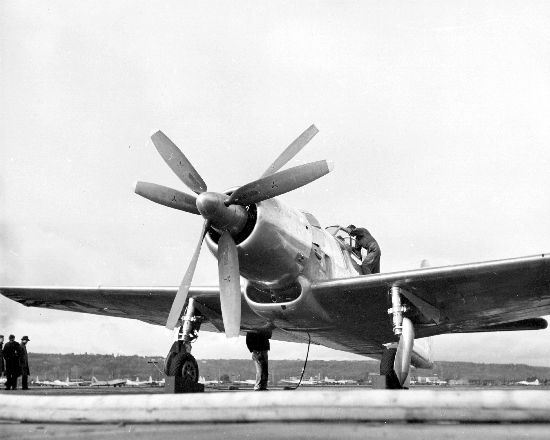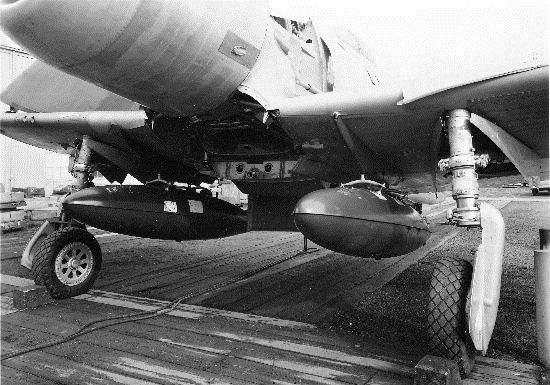Boeing 400 on:
[Wikipedia]
[Google]
[Amazon]
The Boeing XF8B (Model 400) was a single-engine aircraft developed by Boeing during World War II to provide the United States Navy with a long-range shipboard
 The XF8B-1 was, at the time, the largest and heaviest single-seat, single-engine fighter developed in the United States. Boeing called the XF8B-1 optimistically, the "five-in-one fighter" (fighter, interceptor, dive bomber, torpedo bomber, or level bomber). It was powered by a single 3,000 hp (2,200 kW) Pratt & Whitney XR-4360-10 four-row 28-cylinder radial engine, driving two three-bladed contra-rotating
The XF8B-1 was, at the time, the largest and heaviest single-seat, single-engine fighter developed in the United States. Boeing called the XF8B-1 optimistically, the "five-in-one fighter" (fighter, interceptor, dive bomber, torpedo bomber, or level bomber). It was powered by a single 3,000 hp (2,200 kW) Pratt & Whitney XR-4360-10 four-row 28-cylinder radial engine, driving two three-bladed contra-rotating
 To expedite testing and evaluation, a second cockpit was fitted to the first two prototypes to allow a flight engineer to help monitor the test flights. The second seat was easily accommodated in the roomy cockpit.
Although testing of the promising XF8B concept continued into 1946 by the USAAF and 1947 by the US Navy, the end of the war in the Pacific and changing postwar strategy required that Boeing concentrate on building large land-based bombers and transports. The advent of jet fighters led to the cancellation of many wartime piston-engined projects; consequently, since the USAF lost interest in pursuing the project and the U.S. Navy was only prepared to offer a small contract, Boeing chose to wind down the XF8B program. Tests at Boeing Field were marred by an accident in which a test pilot accidentally retracted his landing gear on final approach. Investigation later found this to have been caused by a faulty micro switch. This occurred just as first shift was ending, and as many workers watched from the Plant 2 steps, the XF8B-1 bellied onto the concrete of Boeing Field. As the test program was concluded, the prototypes were scrapped one by one, with ''57986'' lingering on into 1950.
To expedite testing and evaluation, a second cockpit was fitted to the first two prototypes to allow a flight engineer to help monitor the test flights. The second seat was easily accommodated in the roomy cockpit.
Although testing of the promising XF8B concept continued into 1946 by the USAAF and 1947 by the US Navy, the end of the war in the Pacific and changing postwar strategy required that Boeing concentrate on building large land-based bombers and transports. The advent of jet fighters led to the cancellation of many wartime piston-engined projects; consequently, since the USAF lost interest in pursuing the project and the U.S. Navy was only prepared to offer a small contract, Boeing chose to wind down the XF8B program. Tests at Boeing Field were marred by an accident in which a test pilot accidentally retracted his landing gear on final approach. Investigation later found this to have been caused by a faulty micro switch. This occurred just as first shift was ending, and as many workers watched from the Plant 2 steps, the XF8B-1 bellied onto the concrete of Boeing Field. As the test program was concluded, the prototypes were scrapped one by one, with ''57986'' lingering on into 1950.

Boeing XF8B-1
XF8B-1 Fighter-Bomber
{{Authority control Boeing FB8 Carrier-based aircraft FB8, Boeing Aircraft with contra-rotating propellers Single-engined tractor aircraft Low-wing aircraft Aircraft first flown in 1944
fighter aircraft
Fighter aircraft are fixed-wing military aircraft designed primarily for air-to-air combat. In military conflict, the role of fighter aircraft is to establish air superiority of the battlespace. Domination of the airspace above a battlefield ...
. The XF8B was intended for operation against the Japanese home islands from aircraft carrier
An aircraft carrier is a warship that serves as a seagoing airbase, equipped with a full-length flight deck and facilities for carrying, arming, deploying, and recovering aircraft. Typically, it is the capital ship of a fleet, as it allows a ...
s outside the range of Japanese land-based aircraft. Designed for various roles including interceptor, long-range escort fighter, dive-bomber, and torpedo bomber, the final design embodied a number of innovative features in order to accomplish the various roles. Despite its formidable capabilities, the XF8B-1 never entered series production.
Design and development
 The XF8B-1 was, at the time, the largest and heaviest single-seat, single-engine fighter developed in the United States. Boeing called the XF8B-1 optimistically, the "five-in-one fighter" (fighter, interceptor, dive bomber, torpedo bomber, or level bomber). It was powered by a single 3,000 hp (2,200 kW) Pratt & Whitney XR-4360-10 four-row 28-cylinder radial engine, driving two three-bladed contra-rotating
The XF8B-1 was, at the time, the largest and heaviest single-seat, single-engine fighter developed in the United States. Boeing called the XF8B-1 optimistically, the "five-in-one fighter" (fighter, interceptor, dive bomber, torpedo bomber, or level bomber). It was powered by a single 3,000 hp (2,200 kW) Pratt & Whitney XR-4360-10 four-row 28-cylinder radial engine, driving two three-bladed contra-rotating propeller
A propeller (colloquially often called a screw if on a ship or an airscrew if on an aircraft) is a device with a rotating hub and radiating blades that are set at a pitch to form a helical spiral which, when rotated, exerts linear thrust upon ...
s. It would be the largest single-seat piston fighter to fly in the U.S. to date. The large wings featured outer sections which could fold vertically, while the fuselage incorporated an internal bomb bay and large fuel tanks; more fuel could be carried externally. The proposed armament included six 0.50 inch (12.7 mm) machine guns or six 20 mm wing-mounted cannons, and a 6,400 lb (2,900 kg) bomb load or two 2,000 lb (900 kg) torpedoes. The final configuration was a large but streamlined design, featuring a bubble canopy, sturdy main undercarriage that folded into the wings, and topped by a variation on the B-29 vertical tail.
The contract for three prototype
A prototype is an early sample, model, or release of a product built to test a concept or process. It is a term used in a variety of contexts, including semantics, design, electronics, and Software prototyping, software programming. A prototyp ...
s (BuNos ''57984''–''57986'') was awarded 4 May 1943, although only one was completed before the war ended. It first flew in November 1944. The two remaining prototypes were completed after the war, with the third (BuNo ''57986'') evaluated at Eglin Air Force Base by the United States Army Air Forces.
Operational history
 To expedite testing and evaluation, a second cockpit was fitted to the first two prototypes to allow a flight engineer to help monitor the test flights. The second seat was easily accommodated in the roomy cockpit.
Although testing of the promising XF8B concept continued into 1946 by the USAAF and 1947 by the US Navy, the end of the war in the Pacific and changing postwar strategy required that Boeing concentrate on building large land-based bombers and transports. The advent of jet fighters led to the cancellation of many wartime piston-engined projects; consequently, since the USAF lost interest in pursuing the project and the U.S. Navy was only prepared to offer a small contract, Boeing chose to wind down the XF8B program. Tests at Boeing Field were marred by an accident in which a test pilot accidentally retracted his landing gear on final approach. Investigation later found this to have been caused by a faulty micro switch. This occurred just as first shift was ending, and as many workers watched from the Plant 2 steps, the XF8B-1 bellied onto the concrete of Boeing Field. As the test program was concluded, the prototypes were scrapped one by one, with ''57986'' lingering on into 1950.
To expedite testing and evaluation, a second cockpit was fitted to the first two prototypes to allow a flight engineer to help monitor the test flights. The second seat was easily accommodated in the roomy cockpit.
Although testing of the promising XF8B concept continued into 1946 by the USAAF and 1947 by the US Navy, the end of the war in the Pacific and changing postwar strategy required that Boeing concentrate on building large land-based bombers and transports. The advent of jet fighters led to the cancellation of many wartime piston-engined projects; consequently, since the USAF lost interest in pursuing the project and the U.S. Navy was only prepared to offer a small contract, Boeing chose to wind down the XF8B program. Tests at Boeing Field were marred by an accident in which a test pilot accidentally retracted his landing gear on final approach. Investigation later found this to have been caused by a faulty micro switch. This occurred just as first shift was ending, and as many workers watched from the Plant 2 steps, the XF8B-1 bellied onto the concrete of Boeing Field. As the test program was concluded, the prototypes were scrapped one by one, with ''57986'' lingering on into 1950.
Operators
; * United States Army Air Forces * United States NavySpecifications (Boeing XF8B-1)

See also
References
Further reading
* * * *External links
Boeing XF8B-1
XF8B-1 Fighter-Bomber
{{Authority control Boeing FB8 Carrier-based aircraft FB8, Boeing Aircraft with contra-rotating propellers Single-engined tractor aircraft Low-wing aircraft Aircraft first flown in 1944